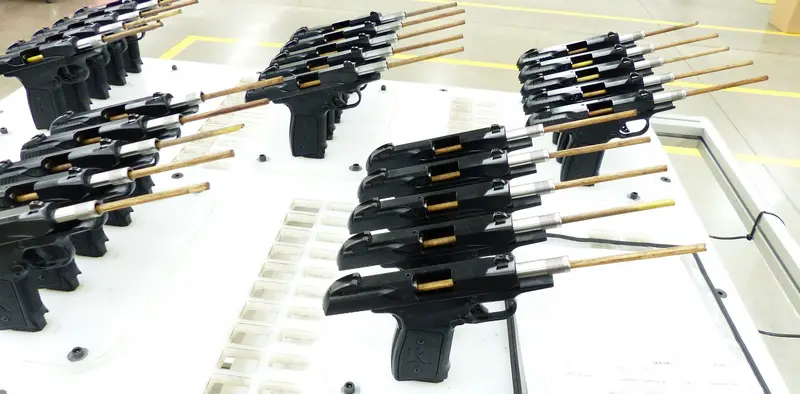The R51 Pistol: Remington's Greatest Failure and Greatest Success?

Julian Hatcher, author of the must-read Hatcher's Notebook, favored the Remington R53 .45 caliber over the Browning 1911 on the basis of better reliability, better accuracy, lighter weight, less recoil, and fewer moving parts. The Model 53 was a scaled-up version of the John Pederson R51 design of 1917. The U.S. Navy after extensive testing of the R53/M53 concluded that “...a simple, rugged and entirely dependable weapon, which should be suitable in every respect for a service pistol.” Nevertheless, the 1911 was too well established for any change to occur, despite the widespread accolades bestowed upon the Model 53.
The R51 9mm was announced in January 2014 and then recalled, clearly an initial flop. The redesigned and re-engineered R51 has been shipping since August 2016. What isn't perhaps readily apparent is that the R51 is the product that has completely changed Remington Arms.
Over the years, I've experienced countless firearms that have not lived up to expectations from just about every manufacturer. Whether Browning, Ruger, Beretta, Benelli, Smith & Wesson, etc., they have all stuffed it up from time to time. There have been recalls, some models have been sheepishly removed from catalogs and websites, and often it is the models never recalled but should have been that we should worry about. One company that doesn't do typically do recalls is Beretta: they just make you buy a new gun. The Beretta Xtrema became the Xtrema2 in a big hurry, with no love for the original Xtrema owners.
The Beretta 391 series (Urika, Urika2) was plagued with broken gas pistons, bad recoil buffers, and a particularly nasty string of defective shell elevators: an issue that never was fixed. There is no question that there should have been multiple recalls, but there never was. The issues with the stock design of the 3 inch Benelli Vinci (smashed fingers) screamed for a redesign, but instead of Benelli directly fixing the issue, but you had to go out and buy another brand new gun, the 3-1/2 inch Vinci, to experience the fix. Whether the Browning A500, the Ruger Gold Label, the new Ruger Red Label, or the current “Recall Kings,” Smith & Wesson / Thompson Center with the I-Bolt, “All Thompson/Center Arms ICON, VENTURE and DIMENSION rifles manufactured before June 13, 2013” and “All Thompson/Center Arms™ Compass® rifles manufactured PRIOR TO September 16, 2016” this stuff does gets really old and does lasting damage to the brand involved.
There can be a huge difference between prototype guns and even initial production runs. Variables of tolerances, tolerance stack-up can easily creep in and anyone involved in manufacturing can tell you that gremlins sneak in, whether or not you feed them after midnight. With the R51, Remington management decided that they had enough and it resulted in a complete change of direction for the company.
Remington now presumes their new products guilty, the opposite of our judicial system. A new Remington firearm is presumed guilty, guilty of not being as good as it could be. For a new Remington model to go into production, it has to be proved innocent. To prove something innocent, you need data collection, it is time-consuming, but that is exactly the process they now take.
You have extensive destructive tests, hot and cold tests, analysis by high speed photography, long-term cycle testing, and very high amounts of live fire. In the case of the re-engineered R51, it was something in the area of 750,000 rounds fired. This same level of extreme pre-release reliability testing has been applied to the V3 shotgun, the new RP9 and RP45 pistols, and other Remington product across the board. It is this investment in prelaunch testing, Remington processes, quality checks, tooling, and procedures that has allowed Remington to offer a lifetime warranty on all of their firearms. I've seen this in action at Remington facilities in Ilion, NY, and in Huntsville, Alabama.
What you have, in order to prove a product innocent, is huge binders of evidence from all of this data collection that engineering, production, research, and management all collaborate on. At the end of this, it still isn't over, for a presentation has to be made to Jim Marcotuli who puts on his “Judge Judy robe” and renders his verdict, whether the evidence is convincing enough or whether more testing and data accumulation is required.
It is an on-going process. Going over one production line in particular, the comment was made that “we don't hire gunsmiths.” In other words, constant quality checks (and tooling wear checks” are performed, so that if at any stage of the process a component are not within tolerance, the entire line shuts down. As quality data accumulation continues, tolerances are routinely revisited so they can be held closer and closer than ever before.
You've no doubt heard the expression, “They don't build them like they used to.” In some cases, that's a good thing, a very good thing indeed. Although very costly and time-consuming initially, the payback is lower scrap rates, lower return rates, a higher level of customer satisfaction, and an overall elevation of the Remington brand in the marketplace. It is a new day at Remington and it will be fun to watch.
Copyright 2016 by Randy Wakeman. All Rights Reserved.












